The ASRock DeskMini A300 Review: An Affordable DIY AMD Ryzen mini-PC
by Ganesh T S on April 26, 2019 8:00 AM ESTBAPCo SYSmark 2018
The ASRock DeskMini A300 was evaluated using our Fall 2018 test suite for small-form factor PCs. In the first section, we will be looking at SYSmark 2018.
Prior to describing the benchmark itself, we should quickly address concerns about using the benchmark to test AMD-based systems, given that AMD is not a part of the BAPCo consortium. In fact, AMD has been pretty vocal against the benchmark, with their last salvo appearing in 2016. AMD had quit BAPCo in 2011 over concerns of the GPU not being represented enough in the benchmarks.
Having analyzed the SYSmark 2018 white paper, and actually followed the execution of the benchmark workloads, we can say that SYSmark 2018 does represent possible usage patterns for a PC used in a business / office setting. Even if one were to side with AMD on the scoring aspect, the benchmark's rather unique energy consumption metric accurately represents the efficiency of the system for the realistic workloads. Overall, we believe that SYSmark 2018 is a good benchmark for systems used in certain scenarios; though it goes without saying that we never put too much stock in any one benchmark, which is why we only use it as one of out several benchmarks in our mini-PC reviews.
Anyhow, BAPCo's SYSmark 2018 is an application-based benchmark that uses real-world applications to replay usage patterns of business users in the areas of productivity, creativity, and responsiveness. The 'Productivity Scenario' covers office-centric activities including word processing, spreadsheet usage, financial analysis, software development, application installation, file compression, and e-mail management. The 'Creativity Scenario' represents media-centric activities such as digital photo processing, AI and ML for face recognition in photos and videos for the purpose of content creation, etc. The 'Responsiveness Scenario' evaluates the ability of the system to react in a quick manner to user inputs in areas such as application and file launches, web browsing, and multi-tasking.
Scores are meant to be compared against a reference desktop (the SYSmark 2018 calibration system, a Dell Optiplex 5050 tower with a Core i3-7100 and 4GB of DDR4-2133 memory to go with a 128GB M.2 SATA III SSD). The calibration system scores 1000 in each of the scenarios. A score of, say, 2000, would imply that the system under test is twice as fast as the reference system.
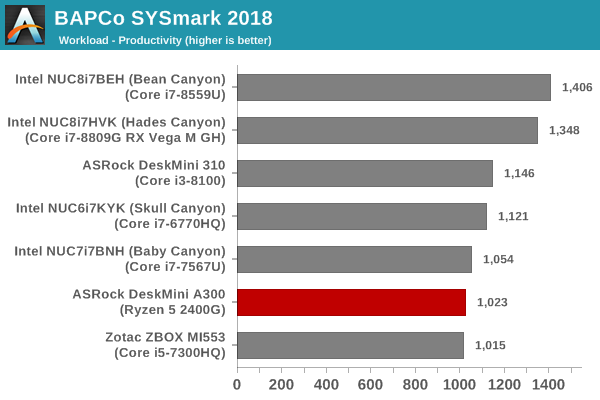
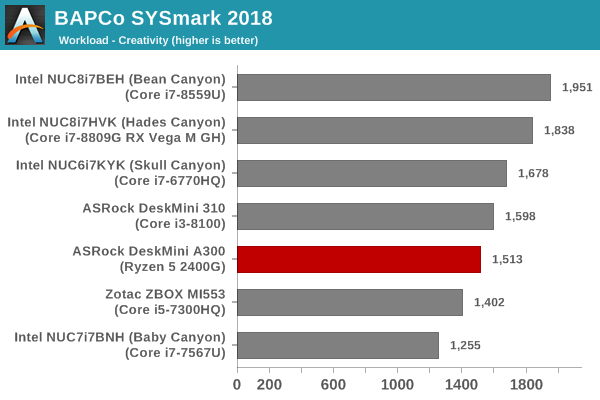
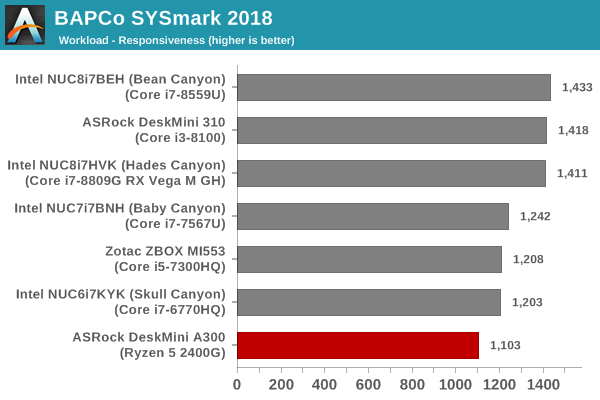
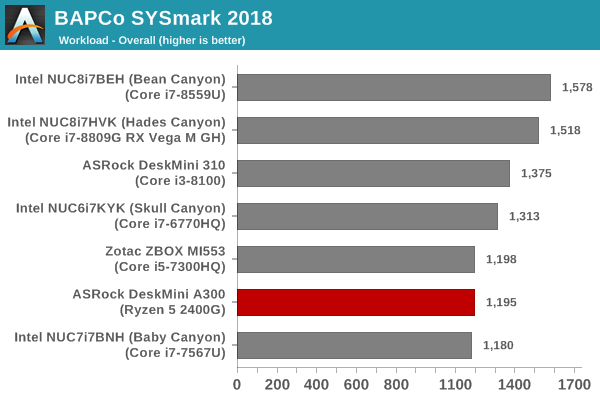
SYSmark 2018 also adds energy measurement to the mix. A high score in the SYSmark benchmarks might be nice to have, but, potential customers also need to determine the balance between power consumption and the efficiency of the system. For example, in the average office scenario, it might not be worth purchasing a noisy and power-hungry PC just because it ends up with a 2000 score in the SYSmark 2014 SE benchmarks. In order to provide a balanced perspective, SYSmark 2018 also allows vendors and decision makers to track the energy consumption during each workload. In the graphs below, we find the total energy consumed by the PC under test for a single iteration of each SYSmark 2018 workload. For reference, the calibration system consumes 5.36 Wh for productivity, 7.71 Wh for creativity, 5.61 Wh for responsiveness, and 18.68 Wh overall.
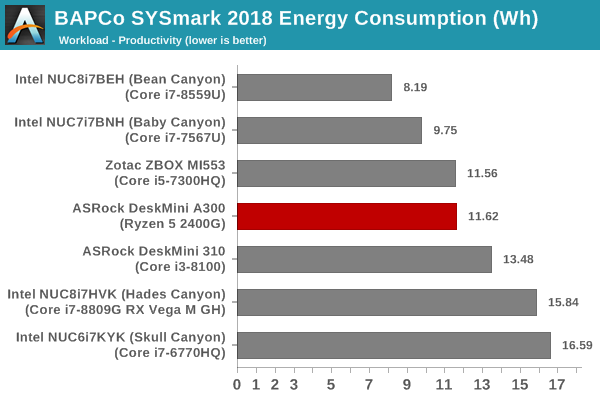


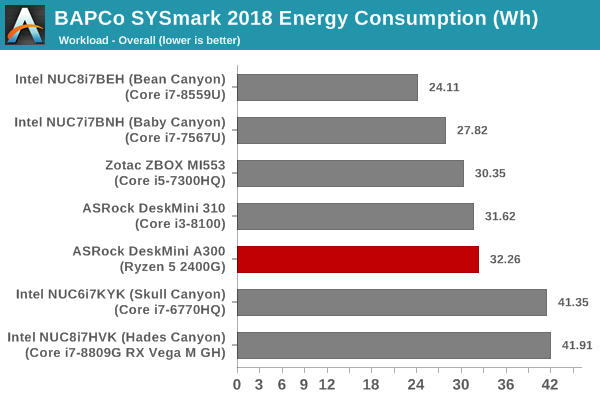
In the rest of the review, our focus will be on comparing the performance of the DeskMini A300 with the Ryzen 5 2400G and the DeskMini 310 with the Core i3-8100. Our builds for the system have approximately the same price point, and they are both contemporary systems. The overall energy consumption for the A300 is only slightly higher than the DeskMini 310, but the benchmark scores are lower. The DeskMini A300 configuration performs as well as the Zotac ZBOX MI553 (with the 45W Core i5-7300HQ) and the Baby Canyon NUC (with the 15W Core i7-7567U). However, those machines consume around 2 to 5 Wh less to achieve those scores.










88 Comments
View All Comments
Alexvrb - Saturday, April 27, 2019 - link
I just want to know if it supports cTDP, and if so, does it work well. Some boards do better than others.CharonPDX - Friday, April 26, 2019 - link
Now that "integrated graphics" are starting to reach actually-usable levels, I'd like to see VR added to these SFF reviews. We keep the Oculus Rift in the living room, but have to bring the "gaming PC" out every time we want to use it. I'd love to get a small "capable enough for basic VR games" PC to just live in the living room to run the Oculus.Relatedly, it mentions the DP, HDMI, and VGA ports - but does the front panel USB-C port allow video output via DisplayPort Alternate Mode? If it can play basic VR games acceptably (BeatSaber is the big one,) I'd rather use the front-panel USB-C with one of Accell's USB-C VR adapters.
GreenReaper - Friday, April 26, 2019 - link
It's "usable" up to 1080p on a single screen. Most VR systems use resolutions higher than this, one in each eye, and require twice the frame rates offered here. Don't get me wrong: I want this too, but if top-end Navi-based APUs *doubled* performance they'd still struggle, and they're a year away. Maybe if we had a dual-APU system? (Man, now I'm imagining this for a console.)piasabird - Friday, April 26, 2019 - link
I have the Intel 310 version of the Desk Mini. I think on your review it is too technical while not stressing the ease at which a 2.5 SSD can be installed. The Data/power connectors on the back of the motherboard make it fairly easy and with not much cable clutter. However, I found the cables were easier to connect if you remove the motherboard first. Since some people may want to use a 2.5 SSD, you should have tested that. I wish a similar design was available in Mini-ITX. However, it seems unavailable on the consumer level for the most modern CPU's like the one used in this review.mikato - Tuesday, April 30, 2019 - link
I completely agree. I don't think it was mentioned anywhere in the review that you can add a 2.5" drive - and you can actually add 2 x 2.5" drives according to the ASRock specs page. That sets it apart from other mini PCs significantly. Most only support 1 x 2.5" drive, or the thin NUCs don't support any. That gives you some solid storage options. You can actually forgo the media server and have both ends of the HTPC in one compact box (front-end with all streaming options, and the file storage for local media).sor - Friday, April 26, 2019 - link
I picked up two for my kids, with 2400Gs. Can’t beat the price. I have them mounted to the backs of their monitors which makes for a compact powerful all in one.I’ve got Ubuntu 19.04 on them and they run Dota2 like butter. Better than my 2018 MacBook Pro with discrete Radeon 560x.
My only ask might be two more rear USB ports, but it hasn’t been an issue so far.
sor - Friday, April 26, 2019 - link
Come on guys! The wraith cooler fits and is clearly superior to the boxed one.It may not be listed as supported dimensionally, but you just need to take the superficial ring off the fan and you can ease it in with a little care.
oliwek - Saturday, April 27, 2019 - link
Or just add a low profile Noctua cooler, it's dead silent even under full load, and you won't ever see (nowhere near) 80 degrees celsius as with the stock cooler!https://noctua.at/en/nh-l9a-am4
sor - Friday, April 26, 2019 - link
I just checked and I’m averaging about 57FPS on my 2400G deskmini A300w in 1080p, all settings max.That’s about 50% better performance than the review sees, which is huge. I am running Ubuntu 19.04 out of the box (no munching with drivers).
I AM using the wraith cooler as mentioned, which is also a difference. Are the windows drivers that bad? Or is it the cooler, or something else?
oliwek - Saturday, April 27, 2019 - link
The stock cooler is adequate for a 35watts athlon 200ge, but I'd avoid those high temps with 65W APUs we see here. I don't understand why not to mod the Wraith cooler as you chose to, as it's delivered with the processor, or else take an aftermarket low profile cooler (the Noctua looks like it was designed around this A300 motherboard).